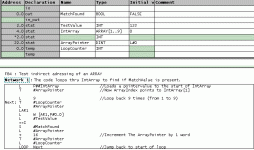Hi people,
I have a problem; well it’s a question actually. I want to program an array what isn’t that difficult but now I want to call a variable in that array by the value of a counter.
Example:
Normally you call a variable by typing the array name and index number like “array[1]”. Now I want the index number variable like “array[“counter value”] where counter value stand for an index number.
Is this possible?..?..
I’m programming in S5/S7 für Windows (something like S5, S7 from Siemens) by the developer “IBH softec”.
I have a problem; well it’s a question actually. I want to program an array what isn’t that difficult but now I want to call a variable in that array by the value of a counter.
Example:
Normally you call a variable by typing the array name and index number like “array[1]”. Now I want the index number variable like “array[“counter value”] where counter value stand for an index number.
Is this possible?..?..
I’m programming in S5/S7 für Windows (something like S5, S7 from Siemens) by the developer “IBH softec”.









